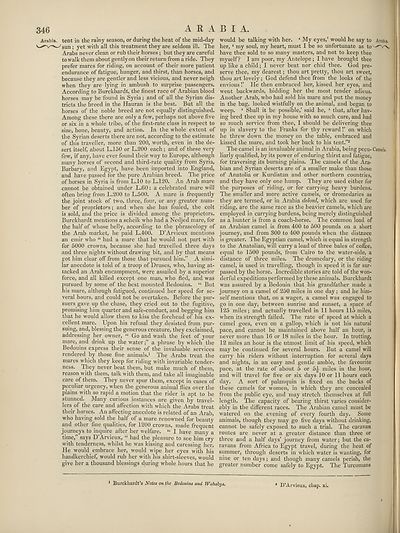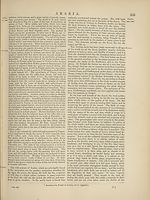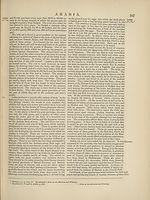Encyclopaedia Britannica > Volume 3, Anatomy-Astronomy
(354) Page 346
Download files
Complete book:
Individual page:
Thumbnail gallery: Grid view | List view

346 A R A
Arabia, tent in the rainy season, or during the heat of the mid-day
SUn; yet with all this treatment they are seldom ill. The
Arabs never clean or rub their horses; but they are careful
to walk them about gently on their return from a ride. They
prefer mares for riding, on account of their more patient
endurance of fatigue, hunger, and thirst, than horses, and
because they are gentler and less vicious, and never neigh
when they are lying in ambush to surprise passengers.
According to Burckhardt, the finest race of Arabian blood
horses may be found in Syria; and of all the Syrian dis¬
tricts the breed in the Hauran is the best. But all the
horses of the noble breed are not equally distinguished.
Among these there are only a few, perhaps not above five
or six in a whole tribe, of the first-rate class in respect to
size, bone, beauty, and action. In the whole extent of
the Syrian deserts there are not, according to the estimate
of this traveller, more than 200, worth, even in the de¬
sert itself, about L.150 or L.200 each; and of these very
few, if any, have ever found their way to Europe, although
many horses of second and third-rate quality from Syria,
Barbary, and Egypt, have been imported into England,
and have passed for the pure Arabian breed. The price
of horses in Syria is from L.10 to L.120. An Arab mare
cannot be obtained under L.60: a celebrated mare will
often bring from L.200 to L.500. A mare is frequently
the joint stock of two, three, four, or any greater num¬
ber of proprietors; and when she has foaled, the colt
is sold, and the price is divided among the proprietors.
Burckhardt mentions a scheik who had a Nedjed mare, for
the half of whose belly, according to the phraseology of
the Arab market, he paid L.400. D’Arvieux mentions
an emir who “ had a mare that he would not part with
for 5000 crowns, because she had travelled three days
and three nights without drawing bit, and by that means
got him clear off from those that pursued him.” A simi¬
lar anecdote is told of a troop of Druses, who, having at¬
tacked an Arab encampment, were assailed by a superior
force, and all killed except one man, who fled, and was
pursued by some of the best mounted Bedouins. “ But
his mare, although fatigued, continued her speed for se¬
veral hours, and could not be overtaken. Before the pur¬
suers gave up the chase, they cried out to the fugitive,
promising him quarter and safe-conduct, and begging him
that he would allow them to kiss the forehead of his ex¬
cellent mare. Upon his refusal they desisted from pur¬
suing, and, blessing the generous creature, they exclaimed,
addressing her owner, “ Go and wash the feet of your
mare, and drink up the watera phrase by which the
Bedouins express their sense of the invaluable services
rendered by those fine animals.1 The Arabs treat the
mares which they keep for riding with invariable tender¬
ness. They never beat them, but make much of them,
reason with them, talk with them, and take all imaginable
care of them. They never spur them, except in cases of
peculiar urgency, when the generous animal flies over the
plains with so rapid a motion that the rider is apt to be
stunned. Many curious instances are given by travel¬
lers of the care and affection with which the Arabs treat
their horses. An affecting anecdote is related of an Arab,
who having sold the half of a mare renowned for beauty
and other fine qualities, for 1200 crowns, made frequent
journeys to inquire after her welfare. “ I have many a
time,” says D’Arvieux, “ had the pleasure to see him cry
with tenderness, whilst he was kissing and caressing her.
He would embrace her, would wipe her eyes with his
handkerchief, would rub her with his shirt-sleeves, would
give her a thousand blessings during whole hours that he
B I A.
would be talking with her. ‘ My eyes,' would he say to Arabia,
her, ‘ my soul, my heart, must I be so unfortunate as to^^v
have thee sold to so many masters, and not to keep thee
myself? I am poor, my Antelope; I have brought thee
up like a child; I never beat nor chid thee. God pre¬
serve thee, my dearest; thou art pretty, thou art sweet,
thou art lovely; God defend thee from the looks of the
envious!’ He then embraced her, kissed her eyes, and
went backwards, bidding her the most tender adieus.
Another Arab, who had sold his mare and put the money
in the bag, looked wistfully on the animal, and began to
weep. ‘ Shall it be possible,’ said he, ‘ that, after hav¬
ing bred thee up in my house with so much care, and had
so much service from thee, I should be delivering thee
up in slavery to the Franks for thy reward!’ on which
he threw down the money on the table, embraced and
kissed the mare, and took her back to his tent.”2
The camel is an invaluable animal in Arabia, being pecu- Camels,
liarly qualified, by its power of enduring thirst and fatigue,
for traversing its burning plains. The camels of the Ara«
bian and Syrian deserts are of a smaller make than those
of Anatolia or Kurdistan and other northern countries,
and they have only one hump. They are used either for
the purposes of riding, or for carrying heavy burdens.
The smaller and more active camels, or dromedaries as
thej' are termed, or in Arabia deloul, which are used for
riding, are the same race as the heavier camels, which are
employed in carrying burdens, being merely distinguished
as a hunter is from a coach-horse. The common load of
an Arabian camel is from 400 to 500 pounds on a short
journey, and from 300 to 400 pounds when the distance
is greater. The Egyptian camel, which is equal in strength
to the Anatolian, will carry a load of three bales of coffee,
equal to 1500 pounds, from Cairo to the water-side, a
distance of three miles. The dromedary, or the riding
camel, is used in travelling, though in speed it is far sur¬
passed by the horse. Incredible stories are told of the won¬
derful expeditions performed by these animals. Burckhardt
was assured by a Bedouin that his grandfather made a
journey on a camel of 250 miles in one day; and he him¬
self mentions that, on a wager, a camel was engaged to
go in one day, between sunrise and sunset, a space of
125 miles; and actually travelled in 11 hours 115 miles,
when its strength failed. The rate of speed at which a
camel goes, even on a gallop, which is not his natural
pace, and cannot be maintained above half an hour, is
never more than 16 or 18 miles in the hour. In trotting,
12 miles an hour is the utmost limit of his speed, which
may be continued for several hours. But a camel will
carry his riders without interruption for several days
and nights, in an easy and gentle amble, the favourite
pace, at the rate of about 5 or 5£ miles in the hour,
and will travel for five or six days 10 or 11 hours each
day. A sort of palanquin is fixed on the backs of
these camels for women, in which they are concealed
from the public eye, and may stretch themselves at full
length. The capacity of bearing thirst varies consider¬
ably in the different races. The Arabian camel must be
watered on the evening of every fourth day. Some
animals, though they may go five days without drinking,
cannot be safely exposed to such a trial. The caravan
routes are never at a greater distance than three or
three and a half days’ journey from water; but the ca¬
ravans from Africa to Egypt travel, during the heat of
summer, through deserts in which water is wanting, for
nine or ten days; and though many camels perish, the
greater number come safely to Egypt. The Turcomans
1 Burckhardt’s Notes on the Bedouins and Wahahjs.
* D’Arvieux, chap. xi.
Arabia, tent in the rainy season, or during the heat of the mid-day
SUn; yet with all this treatment they are seldom ill. The
Arabs never clean or rub their horses; but they are careful
to walk them about gently on their return from a ride. They
prefer mares for riding, on account of their more patient
endurance of fatigue, hunger, and thirst, than horses, and
because they are gentler and less vicious, and never neigh
when they are lying in ambush to surprise passengers.
According to Burckhardt, the finest race of Arabian blood
horses may be found in Syria; and of all the Syrian dis¬
tricts the breed in the Hauran is the best. But all the
horses of the noble breed are not equally distinguished.
Among these there are only a few, perhaps not above five
or six in a whole tribe, of the first-rate class in respect to
size, bone, beauty, and action. In the whole extent of
the Syrian deserts there are not, according to the estimate
of this traveller, more than 200, worth, even in the de¬
sert itself, about L.150 or L.200 each; and of these very
few, if any, have ever found their way to Europe, although
many horses of second and third-rate quality from Syria,
Barbary, and Egypt, have been imported into England,
and have passed for the pure Arabian breed. The price
of horses in Syria is from L.10 to L.120. An Arab mare
cannot be obtained under L.60: a celebrated mare will
often bring from L.200 to L.500. A mare is frequently
the joint stock of two, three, four, or any greater num¬
ber of proprietors; and when she has foaled, the colt
is sold, and the price is divided among the proprietors.
Burckhardt mentions a scheik who had a Nedjed mare, for
the half of whose belly, according to the phraseology of
the Arab market, he paid L.400. D’Arvieux mentions
an emir who “ had a mare that he would not part with
for 5000 crowns, because she had travelled three days
and three nights without drawing bit, and by that means
got him clear off from those that pursued him.” A simi¬
lar anecdote is told of a troop of Druses, who, having at¬
tacked an Arab encampment, were assailed by a superior
force, and all killed except one man, who fled, and was
pursued by some of the best mounted Bedouins. “ But
his mare, although fatigued, continued her speed for se¬
veral hours, and could not be overtaken. Before the pur¬
suers gave up the chase, they cried out to the fugitive,
promising him quarter and safe-conduct, and begging him
that he would allow them to kiss the forehead of his ex¬
cellent mare. Upon his refusal they desisted from pur¬
suing, and, blessing the generous creature, they exclaimed,
addressing her owner, “ Go and wash the feet of your
mare, and drink up the watera phrase by which the
Bedouins express their sense of the invaluable services
rendered by those fine animals.1 The Arabs treat the
mares which they keep for riding with invariable tender¬
ness. They never beat them, but make much of them,
reason with them, talk with them, and take all imaginable
care of them. They never spur them, except in cases of
peculiar urgency, when the generous animal flies over the
plains with so rapid a motion that the rider is apt to be
stunned. Many curious instances are given by travel¬
lers of the care and affection with which the Arabs treat
their horses. An affecting anecdote is related of an Arab,
who having sold the half of a mare renowned for beauty
and other fine qualities, for 1200 crowns, made frequent
journeys to inquire after her welfare. “ I have many a
time,” says D’Arvieux, “ had the pleasure to see him cry
with tenderness, whilst he was kissing and caressing her.
He would embrace her, would wipe her eyes with his
handkerchief, would rub her with his shirt-sleeves, would
give her a thousand blessings during whole hours that he
B I A.
would be talking with her. ‘ My eyes,' would he say to Arabia,
her, ‘ my soul, my heart, must I be so unfortunate as to^^v
have thee sold to so many masters, and not to keep thee
myself? I am poor, my Antelope; I have brought thee
up like a child; I never beat nor chid thee. God pre¬
serve thee, my dearest; thou art pretty, thou art sweet,
thou art lovely; God defend thee from the looks of the
envious!’ He then embraced her, kissed her eyes, and
went backwards, bidding her the most tender adieus.
Another Arab, who had sold his mare and put the money
in the bag, looked wistfully on the animal, and began to
weep. ‘ Shall it be possible,’ said he, ‘ that, after hav¬
ing bred thee up in my house with so much care, and had
so much service from thee, I should be delivering thee
up in slavery to the Franks for thy reward!’ on which
he threw down the money on the table, embraced and
kissed the mare, and took her back to his tent.”2
The camel is an invaluable animal in Arabia, being pecu- Camels,
liarly qualified, by its power of enduring thirst and fatigue,
for traversing its burning plains. The camels of the Ara«
bian and Syrian deserts are of a smaller make than those
of Anatolia or Kurdistan and other northern countries,
and they have only one hump. They are used either for
the purposes of riding, or for carrying heavy burdens.
The smaller and more active camels, or dromedaries as
thej' are termed, or in Arabia deloul, which are used for
riding, are the same race as the heavier camels, which are
employed in carrying burdens, being merely distinguished
as a hunter is from a coach-horse. The common load of
an Arabian camel is from 400 to 500 pounds on a short
journey, and from 300 to 400 pounds when the distance
is greater. The Egyptian camel, which is equal in strength
to the Anatolian, will carry a load of three bales of coffee,
equal to 1500 pounds, from Cairo to the water-side, a
distance of three miles. The dromedary, or the riding
camel, is used in travelling, though in speed it is far sur¬
passed by the horse. Incredible stories are told of the won¬
derful expeditions performed by these animals. Burckhardt
was assured by a Bedouin that his grandfather made a
journey on a camel of 250 miles in one day; and he him¬
self mentions that, on a wager, a camel was engaged to
go in one day, between sunrise and sunset, a space of
125 miles; and actually travelled in 11 hours 115 miles,
when its strength failed. The rate of speed at which a
camel goes, even on a gallop, which is not his natural
pace, and cannot be maintained above half an hour, is
never more than 16 or 18 miles in the hour. In trotting,
12 miles an hour is the utmost limit of his speed, which
may be continued for several hours. But a camel will
carry his riders without interruption for several days
and nights, in an easy and gentle amble, the favourite
pace, at the rate of about 5 or 5£ miles in the hour,
and will travel for five or six days 10 or 11 hours each
day. A sort of palanquin is fixed on the backs of
these camels for women, in which they are concealed
from the public eye, and may stretch themselves at full
length. The capacity of bearing thirst varies consider¬
ably in the different races. The Arabian camel must be
watered on the evening of every fourth day. Some
animals, though they may go five days without drinking,
cannot be safely exposed to such a trial. The caravan
routes are never at a greater distance than three or
three and a half days’ journey from water; but the ca¬
ravans from Africa to Egypt travel, during the heat of
summer, through deserts in which water is wanting, for
nine or ten days; and though many camels perish, the
greater number come safely to Egypt. The Turcomans
1 Burckhardt’s Notes on the Bedouins and Wahahjs.
* D’Arvieux, chap. xi.
Set display mode to:
![]() Universal Viewer |
Universal Viewer | ![]() Mirador |
Large image | Transcription
Mirador |
Large image | Transcription
Images and transcriptions on this page, including medium image downloads, may be used under the Creative Commons Attribution 4.0 International Licence unless otherwise stated. ![]()
| Encyclopaedia Britannica > Encyclopaedia Britannica > Volume 3, Anatomy-Astronomy > (354) Page 346 |
|---|
| Permanent URL | https://digital.nls.uk/193761950 |
|---|
| Attribution and copyright: |
|
|---|---|
| Shelfmark | EB.16 |
|---|---|
| Description | Ten editions of 'Encyclopaedia Britannica', issued from 1768-1903, in 231 volumes. Originally issued in 100 weekly parts (3 volumes) between 1768 and 1771 by publishers: Colin Macfarquhar and Andrew Bell (Edinburgh); editor: William Smellie: engraver: Andrew Bell. Expanded editions in the 19th century featured more volumes and contributions from leading experts in their fields. Managed and published in Edinburgh up to the 9th edition (25 volumes, from 1875-1889); the 10th edition (1902-1903) re-issued the 9th edition, with 11 supplementary volumes. |
|---|---|
| Additional NLS resources: |
|

